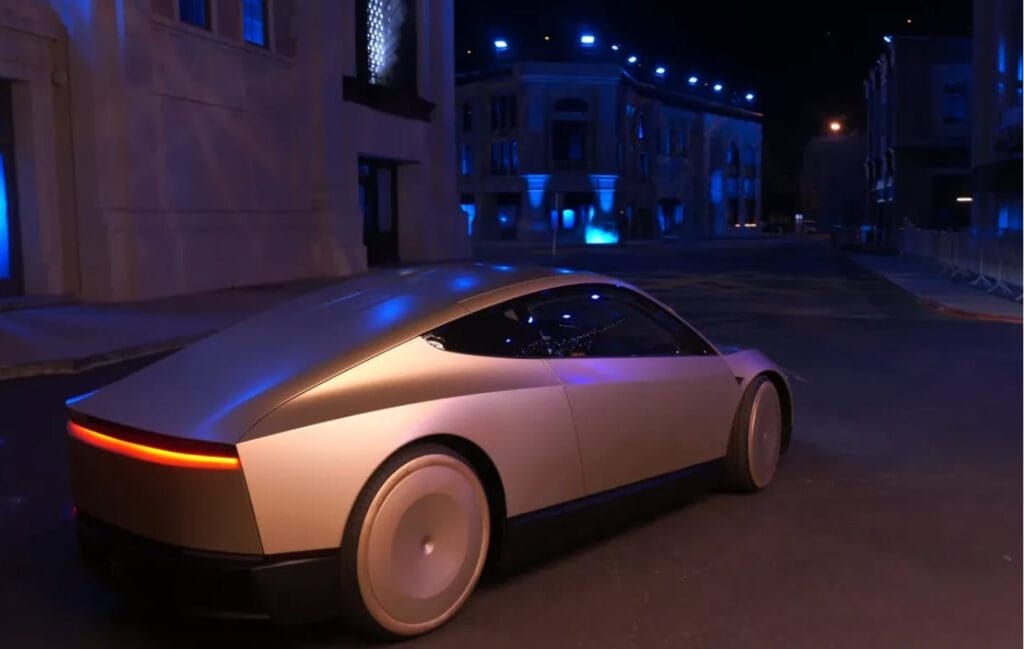Elon Musk’s vision for autonomous transport has taken a significant step forward with the unveiling of Tesla‘s Robotaxi, officially named the Cybercab. Revealed to the world during an event at Warner Bros. Studios in Los Angeles, this futuristic vehicle represents Tesla’s boldest venture into fully autonomous travel yet, promising to redefine urban mobility with its innovative features and competitive pricing.
ALSO READ: Spotify Offline Backup will make listening without internet better
The Cybercab Design and Features
The Cybercab’s design echoes the aesthetics of its sibling, the Cybertruck, but with a sleeker, more aerodynamic profile suited for urban environments. Unlike its truck counterpart, the Cybercab sports a two-seater layout, emphasizing its role as a personal mobility solution rather than a goods transporter. Its most striking feature, however, is the complete absence of a steering wheel or pedals, underscoring its purpose as a fully autonomous vehicle. Inside, the Cybercab offers a spacious passenger area, designed for comfort rather than control. This design choice not only highlights its autonomous nature but also hints at Tesla’s vision for future commuting where passengers are just that — passengers, not drivers. The vehicle is equipped with Tesla’s advanced autonomous driving technology, promising a safer, more efficient ride with an operational cost projected to be around $0.20 per mile, significantly undercutting traditional taxi services.
Price & Release date
Priced at under $30,000, the Cybercab positions itself as Tesla’s most affordable vehicle yet. This pricing strategy aims to democratize access to autonomous travel, making it feasible for a broader audience, not just the elite. The economic model behind this pricing is Tesla’s belief in the cost-effectiveness of autonomous vehicles over time, potentially turning the Cybercab into a common sight on city streets as a shared mobility solution rather than personal ownership.

Tesla has set an ambitious timeline for the Cybercab, with production slated to begin before 2027. Elon Musk, known for his optimistic timelines, has this time been slightly cautious, suggesting a flexible approach that might see the Cybercab in production as early as 2026. This schedule reflects Tesla’s aggressive push towards autonomy, aiming to make the Cybercab not just a concept but a tangible reality in the near future.
The Broader Impact
The introduction of the Cybercab isn’t merely about adding another model to Tesla’s lineup; it’s a step towards Musk’s vision of a world transformed by autonomous transport. This vehicle could significantly alter urban planning, reduce the need for parking spaces, and minimize traffic congestion due to its efficiency and potential for shared usage models. Moreover, the Cybercab’s development has been paralleled by Tesla’s advancements in its Full Self-Driving (FSD) technology, indicating a broader ecosystem where vehicles, be they personal or commercial, contribute to a network of autonomous mobility.
Despite the excitement, the path to widespread adoption of the Cybercab will be fraught with challenges. Regulatory hurdles, public acceptance of driverless technology, and ensuring the technology’s safety are just a few of the obstacles Tesla must overcome. However, Elon Musk’s track record of defying odds might just see the Cybercab not only meet but exceed expectations, potentially setting a new standard for urban transport. In conclusion, the Tesla Cybercab represents more than just a new vehicle; it’s a glimpse into a future where autonomous vehicles could become the norm. With its innovative design, competitive pricing, and aggressive timeline for release, Tesla’s Robotaxi could indeed be the herald of a new era in transportation.

